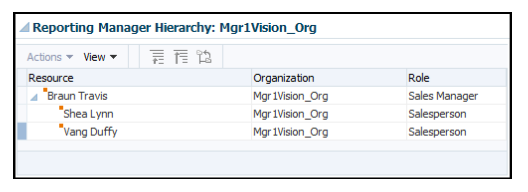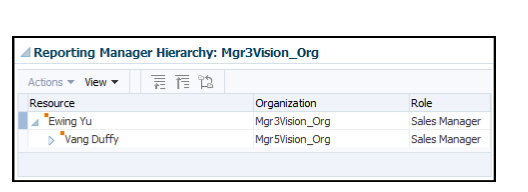Examples of Changing a Resource from Non-Manager to a Manager Role
You can make role-change related updates to a resource by changing the resource information such as resource role code and resource role type code. The scenarios herein illustrate the different role-change related updates you can make to a resource.
-
Sales Representative role changed to Sales Manager under the same manager
-
Sales Representative role changed to Sales Manager under a different manager
Sales Representative Role Changed to Sales Manager under the Same Manager
Shea Lynn is a Sales Representative reporting to Braun Travis. The reporting hierarchy and organization details of Shea Lynn are as shown in this image:

In this scenario, Shea's role is changed to a Sales Manager reporting to Braun Travis, without any change in the reporting hierarchy. To change the role of Shea Lynn to Sales Manager, you must create a source file (CSV) with the attributes and import it, as explained in this table.
|
Attribute Name |
Value |
|---|---|
|
ResourcePartyNumber |
|
|
ResourceOrgRoleCode |
SALES_MANAGER |
|
ResourceOrganization |
Mgr4Vision_Org |
|
ResourceParentOrganizationName |
Mgr1Vision_Org |
-
Go to .
-
Click Create Import Activity in the Manage Imports page.
-
In the Enter Import Options page, provide a name for the import activity, and select Resource from the Object drop-down list.
-
Select the CSV file in the File Name field, and click Next.
-
The source and target attributes are automatically mapped in the Map Fields page. Review and edit the mappings if required.
-
Check the file for unmapped columns or data format issues by clicking Validate Data. Click Next.
Note:Validation errors, if any, are displayed on the Mapping Validation screen. If you get warnings about unmapped columns, then you can ignore these columns and proceed to submit the import job. Validations are for informational purposes and applicable only for low-volume imports.
-
Review the import details on the Review and Submit page, and click Submit when you're ready.
You run the scheduled process Reporting Hierarchy Generation to re-generate the resource
reporting hierarchy when there is a change in the organization hierarchy.
For more information about the Reporting
Hierarchy Generation scheduled process, see the section
"Reporting Hierarchy Generation" in the Understanding
Scheduled Processes guide.
After your import runs successfully, send the pending LDAP user update requests:
-
In the Navigator, click Scheduled Processes.
-
In the Scheduled Processes page, click Schedule New Process.
-
In the Schedule New Process dialog box, from the Name drop-down list, search for Send Pending LDAP Requests.
-
From the search results, select Send Pending LDAP Requests and click OK.
-
In the Process Details dialog box, click Submit.
-
In the Confirmation dialog box, click OK.
-
Click Close.
-
In the Scheduled Processes page, click the Refresh icon.
-
Verify if the status of the process has completed successfully.
The reporting hierarchy and organization details of Shea Lynn after her role has been changed from SALES_REPRESENTATIVE to SALES_MANAGER as shown in this image:

Sales Representative Role Changed to Sales Manager under a Different Manager
Vang Duffy is a Sales Representative reporting to Braun Travis. The reporting hierarchy and organization details of Vang Duffy are shown in this image:

In this scenario, Vang's role is changed to a Sales Manager and would be reporting to Ewing Yu, a different manager. To change Vang Duffy's role to Sales Manager under Ewing Yu, you must create a source file (CSV) with the following attributes and import it, as explained in this table.
|
Attribute Name |
Value |
|---|---|
|
ResourcePartyNumber |
|
|
ResourceOrgRoleCode |
SALES_MANAGER |
|
ResourceOrganization |
Mgr4Vision_Org |
|
ResourceParentOrganizationName |
Mgr3Vision_Org |
|
ResourceOrgManagerEmail |
ewing.yu@vision.com |
-
Go to .
-
Click Create Import Activity in the Manage Imports page.
-
In the Enter Import Options page, provide a name for the import activity, and select Resource from the Object drop-down list.
-
Select the CSV file in the File Name field, and click Next.
-
The source and target attributes are automatically mapped in the Map Fields page. Review and edit the mappings if required.
-
Check the file for unmapped columns or data format issues by clicking Validate Data. Click Next.
Note:Validation errors, if any, are displayed on the Mapping Validation screen. If you get warnings about unmapped columns, then you can ignore these columns and proceed to submit the import job. Validations are for informational purposes and applicable only for low-volume imports.
-
Review the import details on the Review and Submit page, and click Submit when you're ready.
You run the scheduled process Reporting Hierarchy Generation to re-generate the resource
reporting hierarchy when there is a change in the organization hierarchy.
For more information about the Reporting
Hierarchy Generation scheduled process, see the section
"Reporting Hierarchy Generation" in the Understanding
Scheduled Processes guide.
After your import runs successfully, send the pending LDAP user update requests:
-
In the Navigator, click Scheduled Processes.
-
In the Scheduled Processes page, click Schedule New Process.
-
In the Schedule New Process dialog box, from the Name drop-down list, search for Send Pending LDAP Requests.
-
From the search results, select Send Pending LDAP Requests and click OK.
-
In the Process Details dialog box, click Submit.
-
In the Confirmation dialog box, click OK.
-
Click Close.
-
In the Scheduled Processes page, click the Refresh icon.
-
Verify if the status of the process has completed successfully.
The reporting hierarchy and organization details of Vang Duffy after his role has been changed from SALES_REPRESENTATIVE to SALES_MANAGER under Ewing Yu are as follows:
